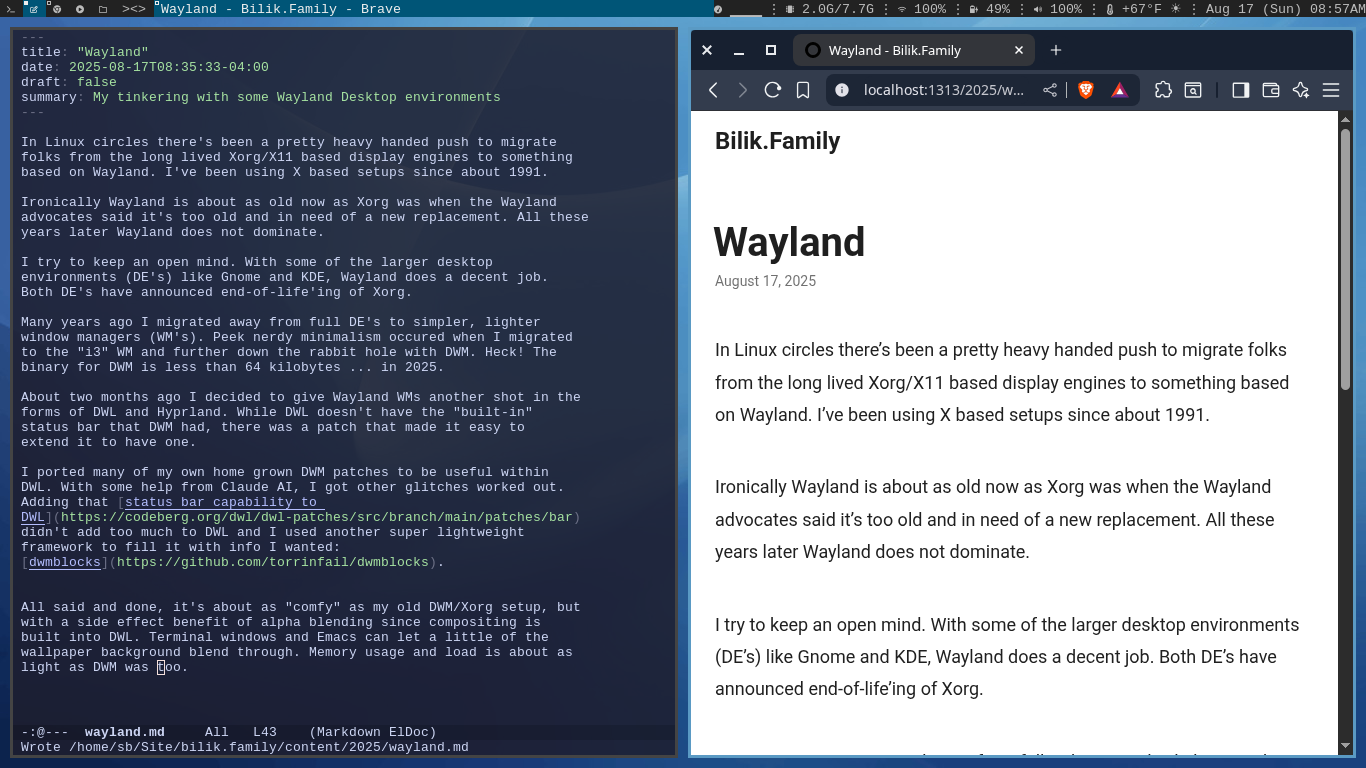The Debate
In Linux circles there’s been a pretty heavy-handed push to migrate folks from the long-lived Xorg/X11-based display engines to something based on Wayland. I’ve been using X-based setups since about 1991.
Ironically, Wayland is about as old now as Xorg was when the Wayland advocates said it’s too old and in need of a new replacement. All these years later, Wayland does not dominate.
I try to keep an open mind. With some of the larger desktop environments (DE’s) like Gnome and KDE, Wayland does a decent job. Both DE’s have announced end-of-life for Xorg.
Many years ago I migrated away from full DE’s to simpler, lighter window managers (WM’s). Peek nerdy minimalism occurred when I migrated to the “i3” WM and went further down the rabbit hole with DWM. Heck! The binary for DWM is less than 64 kilobytes … in 2025.
DWL
About two months ago I decided to give Wayland WMs another shot in the forms of DWL and Hyprland. While DWL doesn’t have the “built-in” status bar that DWM had, there was a patch that made it easy to extend it to have one.
I ported many of my own home grown DWM patches to be useful within DWL. With some help from Claude AI, I got other glitches worked out. Adding that status bar capability to DWL didn’t add too much to DWL and I used another super lightweight framework to fill it with the info I wanted: dwmblocks.
All said and done, it’s about as “comfy” as my old DWM/Xorg setup, but with the side effect benefit of alpha blending since compositing is built into DWL. Terminal windows and Emacs can let a little of the wallpaper background blend through. Memory usage and load are about as light as DWM was too.

Hyprland
If you scan Reddit’s /r/unixporn for nerds’ efforts at “ricing” their desktops, Hyprland has dominated these past couple of years. It certainly has some of the best “eye candy” to be found in Wayland compositors.
I set it up and worked with Claude to build in some of the windowing functionality I’d built in DWM and DWL with a few hundred lines of C. In the case of Hyprland, it took an external shell script that is called from within Hyprland rather than being able to build the capability in.
Next came a status bar for the top of the display. In Hyprland a status bar is always a separate process. Many of the popular ones use a lot of code to provide endless “feature-ism”. I chose to use the popular “waybar”. First I had to tweak that earlier shell script to account for the space that the status bar would take. Then I spent a couple of hours trying to get a bar setup, but was spinning my wheels a lot. I can see why many in the Linux space make fun of nerds wasting time like this. It shouldn’t take hours to make a status bar.
I guess I’m a bit biased. Unlike many of the posters on Reddit’s UnixPorn subreddit, I’m good at C and can put into low-level code something that will get the job done with minimal overhead. My DWL build is about 256KB and my dwmblocks is about 16KB. Those are numbers we used to deal with in the 1990s.
Why even bother?!
Why do you care, Scott?? I don’t know for certain. Part of it stems from the fact that – SSD’s and AI aside – it feels like a lot of the computing progress gets blunted by lazy programming. A modern laptop doing word-processing, spreadsheets, presentations, etc. doesn’t feel significantly better than it did in the late 1990’s. Then we had machines with 16 megabytes of memory, now we have 16 GIGAbytes. Back then we had a single 32bit CPU running in the hundreds of Mhz. Now we have quad-core (or better) 64bit CPUs running at 2 to 5 GIGAHertz.
In a way it reminds me of the progress in automotive safety. I would posit that all of these advances in safety, power, and handling have made us worse drivers. Or worse, more aggressive drivers. In that respect I almost look forward to self driving technologies.
Ah well, it’s a hobby. Some guys like to be in the garage, working on their project cars, tuning this and upgrading that so their 80’s-era Toyota Supra can run even better than when it was new. For me it’s this 10 year old, 11 inch MacBook Air that still screams in 2025.